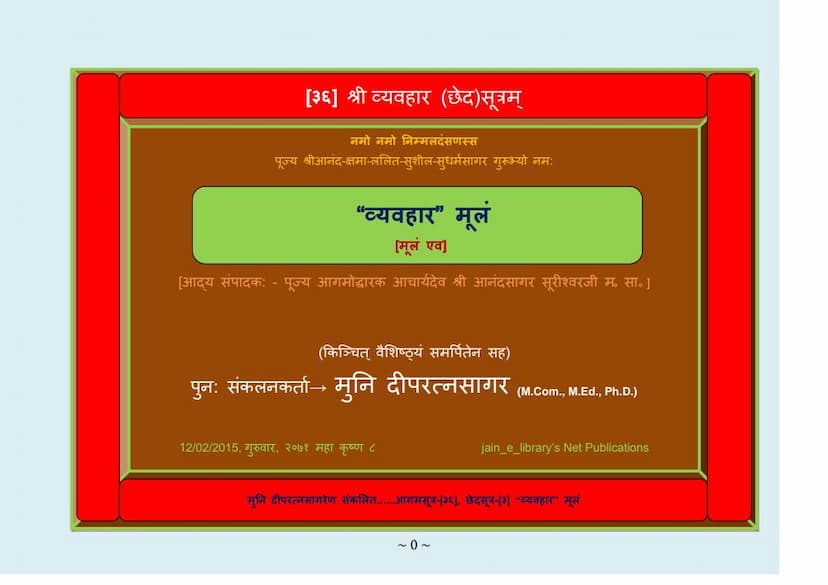Aagam 36 VYAVAHAAR Moolam Evam
Added to library: September 1, 2025

Summary
Here's a comprehensive summary of the provided Jain text, "Aagam 36 VYAVAHAAR Moolam evam" by Dipratnasagar and Deepratnasagar, based on the provided pages:
Title and Authorship: The book is titled "Aagam 36 VYAVAHAAR Moolam evam" (Āgam 36 Vyavahār Mūlaṃ Evam). It is presented as the 36th Āgam, specifically the Chhedasutra "Vyavahār" (व्यवहार). The original compilation and editing are attributed to Pujya Āgmoddhārak Āchārya Dev Shri Ānand Sāgar Suriśvarji M.S. The re-compilation and editing for this specific publication are done by Muni Deepratnasagar (M.Com., M.Ed., Ph.D.). The publication date is given as Thursday, December 2, 2015, corresponding to Mahā Krishna 8, 2071. It is a Net Publication of jain_e_library.
Content and Structure: The "Vyavahār" Chhedasutra is presented in its original (Moolam) form. The text is divided into various "Uddesh" (उद्देश), which are essentially chapters or sections. The provided pages show the beginning of Uddesh 1, Uddesh 2, Uddesh 3, Uddesh 4, Uddesh 5, Uddesh 7, Uddesh 8, and Uddesh 10. Each Uddesh begins with a statement of the Uddesh number and the corresponding starting "Moolam" (मूलं) verse number.
Key Aspects of the Publication:
- Preservation and Accessibility: The primary goal of this publication is to preserve and make accessible the valuable Chhedasutras of Jainism. Muni Deepratnasagar mentions that he has previously published 45 Āgams and also 6+1 Chhedasutras. This particular publication of "Vyavahār" is a part of that larger effort to serve the Āgams.
- Reference to Original Texts: The publication acknowledges that the "Vyavahār" Chhedasutra was inscribed on stone plates at Shatrunjay Tirth and on copper plates in Suratnagar. The current publication is based on photostreams of these original texts, which were then formatted into separate books and made available online and on DVDs.
- Purpose and Motivation: Muni Deepratnasagar expresses his motivation stems from the deep respect and devotion people have for Pujya Sagarānandsuriśvarji (Āchārya Shri Ānand Sāgar Sūriśvarjī). By including these 6+1 Chhedasutras, the intention is to ensure that any future collections are not perceived as incomplete (i.e., lacking these important texts).
- Editorial Features:
- Page Formatting: A special format has been created where the original edited pages of Pujya Shri Sagarānandsuriśvarji are presented as they are.
- Clear Identification: The Āgam's name, the study (Adhyayan) or Uddesh, and the original verse or Gatha numbers are clearly indicated at the top of each page for easy understanding.
- Sequence Numbers: Left-side indicates the Āgam's sequence and the sequence within this particular edition. A "Deep Anukram" (दीप अनुक्रम) is also provided, which serves as an entry point to their other publications in Prakrit, Sanskrit, Hindi, Gujarati, and English.
- Distinguishing Sutras and Gathas: Where verses are found, parentheses
(-)are used. For Gathas,||-||lines or the word "Gatha" are used. - Index (Anukramṇikā): An index is provided, listing each study or topic along with the page numbers of this edition, aiding practitioners in quickly accessing their desired content.
- Footnotes: Specific footnotes are included at the bottom of many pages, providing information about the core subject matter of the page, original print errors, or numbering mistakes.
- Methodology: The "Moolam" (मूलं) text is presented, with "Deep Anukram" (दीप अनुक्रम) numbers alongside the original verse numbers for cross-referencing. The text itself appears to be in Prakrit.
- Nature of the Text: Based on the snippets, the "Vyavahār" Chhedasutra deals with rules, regulations, and consequences within the monastic order (Muni and Āryikā). Topics include:
- Penances and Retractions (Parihāra): Detailed verses discuss the duration and consequences of various penances, such as monthly, bi-monthly, quarterly, etc., and what happens if they are observed or not.
- Monastic Conduct: Discussions on acceptable and unacceptable behavior for monks and nuns, including interactions with lay people (Sāgāriya), obtaining alms, accepting food, and respecting rules.
- Types of Monks and Nuns: Categories and classifications of monks (e.g., based on their level of practice, knowledge, or seniority like Āchārya, Upādhyāya, Ther, Tapaśvi, Śeva, Gilāna, Sādharmika, Gaṇa, etc.) and nuns.
- Acceptance and Rejection of Items/Food: Rules about what can be accepted and rejected, and by whom, especially concerning householders (Sāgāriya).
- Relationships and Interactions: Rules governing interactions between monks, nuns, and their teachers (Āchārya, Upādhyāya).
- Penance and its Application: The text elaborates on the correct procedures for performing penances, confessing wrongdoings, and the consequences of not adhering to them.
- Specific Offenses and Corrections: Various types of offenses and the appropriate corrections or penances to be applied are outlined.
- Dietary Rules: Some verses touch upon rules related to food intake, especially concerning different types of food and when they can be accepted.
- Classification of Conduct: The text categorizes conduct into different types, often based on the degree of adherence to rules or the nature of the offense.
Overall Significance: This publication of the "Vyavahār" Chhedasutra is a significant effort to preserve and disseminate one of the foundational texts of Jain monasticism. It provides a scholarly presentation, making the ancient Prakrit text accessible to a modern audience with helpful cross-referencing and contextual information, thereby contributing to the study and practice of Jainism. The emphasis is on the meticulous effort undertaken by Muni Deepratnasagar, building upon the legacy of his predecessors, to ensure the authenticity and widespread availability of these sacred scriptures.